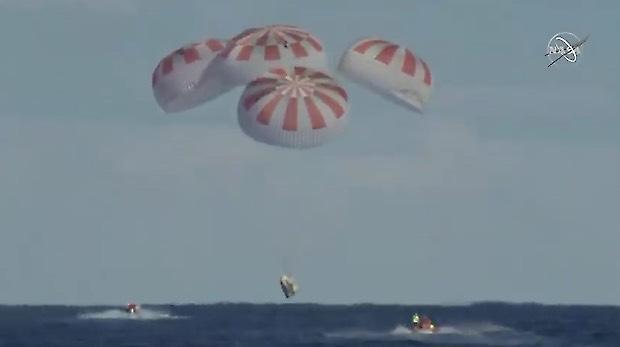SpaceX crew ship returns to Earth after historic flight
SpaceX's Crew Dragon spacecraft wrapped up a historic unpiloted maiden test flight Friday, plunging to an Atlantic Ocean splashdown after a five-day visit to the International Space Station. The Crew Dragon is the first new spacecraft designed to carry astronauts to orbit since the shuttle's debut in 1981.
Descending under four huge parachutes, the capsule, charred by its hypersonic plunge back into the atmosphere, dropped to an on-target, on-time splashdown in calm seas, well within sight of SpaceX support ships stationed nearby in the recovery zone some 265 miles northeast of cape Canaveral.
Assuming a detailed post-flight inspection and data analysis confirm the capsule's apparently problem-free performance, NASA will be a major step closer to launching two astronauts aboard the SpaceX Crew Dragon capsule this summer, the first flight of a U.S. crew from American soil since the shuttle made its final flight in 2011.
"When you kind of look overall at this mission, it was a great dress rehearsal," said Steve Stich, a veteran flight director and deputy manager of NASA's Commercial Crew Program. "We learned a phenomenal amount in the prelaunch timeframe ... and on orbit, we got a lot of great data on the vehicle in terms of the thermal performance, power performance. The vehicle really did better than we expected.
"This flight really sets us up well for the rest of the year," he added. "I don't think we saw really anything on the mission so far ... that would preclude us having the crewed mission later this year."
Waiting in the wings is Boeing and its CST-100 Starliner capsule, being prepared for an unpiloted test flight this spring and its initial piloted launch this fall.
Whenever one or both spacecraft begin operational flights to the station, possibly by the end of the year, NASA will finally be able to end its sole reliance on Russian Soyuz spacecraft to ferry astronauts to and from low-Earth orbit at a cost of more than $80 million a seat.
"Fifty years after humans landed on the moon for the first time, America has driven a golden spike on the trail to new space exploration feats through the work of our commercial partner SpaceX," astronaut Anne McClain said as the Crew Dragon departed the space station.
"It won't be long before our astronaut colleagues are aboard Crew Dragon and Boeing's Starliner vehicle, and we can't wait."
Launched last Saturday atop a SpaceX Falcon 9 rocket, the Crew Dragon spacecraft executed a flawless rendezvous with the International Space Station, catching up with the outpost early Sunday and, after a series of tests, gliding in for a smooth automated docking at the lab's forward port.
McClain, station commander Oleg Kononenko and Canadian astronaut David Saint-Jacques quickly inspected the craft, set up ventilation ducts and unloaded about 400 pounds of crew supplies and equipment. The capsule was repacked with about 300 pounds of material for return to Earth, including a failed spacesuit component and two cold bags loaded with experiment samples.Hatches were closed at midday Thursday and right on time, at 2:31 a.m. Friday, latches holding the Crew Dragon in place retracted and the ship's flight computer executed a series of thruster pulses to slowly pull away from the station.
After dropping behind and below the lab, the Crew Dragon adjusted its orbit and jettisoned its empty trunk section, an unpressurized cargo compartment behind the crew compartment, to set the stage for entry.
Then, a few seconds before 7:53 a.m., the Crew Dragon's braking rockets fired up for a planned 15-minute 25-second burn, slowing the ship and dropping the far side of its orbit into the atmosphere. After a half-hour freefall, the spacecraft slammed into the top of the thick lower atmosphere at a velocity of nearly five miles per second.
Protected by an advanced heat shield, the Crew Dragon quickly slowed in a blaze of atmospheric friction, rapidly shedding horizontal velocity and dropping steeply toward the Earth, descending along a northwest-to-southeast trajectory across the eastern United States.
Company founder Elon Musk said during a post-launch news conference last Saturday that the capsule's hypersonic entry, along with launch, rendezvous and docking, posed the greatest risks. The entry was a concern, he said, because the spacecraft's shape is not as symmetrical as the version used to carry cargo to the station.
"The backshell is not symmetric in the way Dragon 1 is, it's not sort of a smooth conic like Dragon 1 is, you've got the launch escape thruster pods that could potentially cause a roll instability on re-entry," he said. "I think it's unlikely, we've run simulations a thousand times, but this is a possibility.
"Will the parachutes deploy correctly? And then will the system guide Dragon to the right location and splashdown safely? I'd say hypersonic re-entry is probably my biggest concern, just because of the asymmetric backshell."
But right on schedule, two drogue chutes popped out to slow and stabilize the ship, followed a few minutes later by four main parachutes. Spectacular television views from a NASA WB-70 research jet showed the spacecraft surrounded by a sheath of super-heated plasma before cameras on the recovery ship caught sight of the capsule as its parachutes deployed.
Splashdown occurred at 8:45 a.m., almost exactly matching pre-entry predictions.
SpaceX recovery crews and NASA observers were stationed nearby. The crew of a recovery ship named GO Searcher hauled the spacecraft aboard for return to Port Canaveral and detailed post-flight inspections.
"We're very interested in seeing the data," said astronaut Mike Hopkins, in training to fly aboard the second piloted Crew Dragon mission. "I suspect there's going to be some lessons learned, some improvements, some changes that we're going to have to make from this. That's all part of the testing process."
Astronaut Shane Kimbrough observed the entry and splashdown from the deck of a recovery ship and offered an immediate observation.
"It's been 45 or 50 minutes since splashdown, and I'm thinking, you know what, there's a crew in there," he said, imagining future piloted missions. "And that's a long time to be waiting to get picked up, so we'll tighten up that timeline a bit, just knowing the crew's probably not going to feel very well at this point, and the sooner we can get them out and get them on deck, and eventually back on land will help their recovery process."






